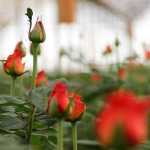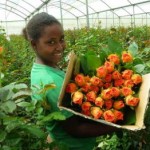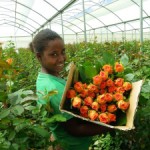 A lot has been said about how Ethiopia is attracting investment from abroad, and the flower sector is right in middle of it all.
A lot has been said about how Ethiopia is attracting investment from abroad, and the flower sector is right in middle of it all.
Compared to its neighbor Kenya, Ethiopia’s geographical location favors this sector in terms of proximity to the European and Middle Eastern markets, experts proclaim. And this is one of the reasons for attracting more Foreign Direct Investment (FDI) to Ethiopia during the past couple of years.
The demand for this luxury product has also been appreciating in the international market in recent years. At the end of 2008, international floral transaction and related products reached USD 40 billion. The Netherlands is the leading exporter, accounting for some 54 percent of world trade in flowers. Floriculture is one of the booming sectors in Ethiopia. It was only in 1997 that the first private floriculture companies in Ethiopia, Meskel Flower and Ethio–Flora, started activities on a few hectares of land. Currently, over 84 companies grow flower in Ethiopia, 70 of which are either foreign-owned or joint ventures between Ethiopia and a foreigner.
Ethiopia’s vast land, favorable climate and water resources combine to make it an incredible hub for investment, say experts.
Located in the Horn of Africa, Ethiopia is the gateway to the Middle East and Europe. This geographical proximity provides the major exporters in the world unparalleled access to the Ethiopian floricultural market.
Currently being produced in Ethiopia is a number of flower types, including roses, gypsophilia, hypericum, limonium, carnations and chrysanthemum.
Flora Culture International—a leading investor in Ethiopia’s floriculture sector—has described parts of the country south of Addis Ababa “as having a better potential than the Naivasha area in Kenya, where well over 50 percent of Kenya’s flowers are grown.”
Currently, many Dutch-owned flower farms operate in Ethiopia, and more than 70 percent of Ethiopia’s floriculture produce goes to the Dutch market. In addition, there is a very close relationship between the two nations in the floriculture sector, which has led to the Ethio-Netherlands Horticulture Partnership Agreement.
The Former Dutch Ambassador to Ethiopia, Alphons Hennekens has been credited for these close ties between the two nations and their respective flower sectors. The ambassador is also hailed for his role in increasing the sector’s visibility in the world.
Once he reportedly said, “The fact that a lot of Dutch companies are deciding to join the sector in Ethiopia is telling about the business and investment climate in Ethiopia. We have seen more spectacular growth in the floriculture sector here than anywhere else in the world”.
No doubt, by volume of export, the cut flowers sector is growing over time. A substantial number of investors have started operating in Ethiopia due to the Government’s focus on this sector and the unparalleled incentive that the country has afforded the floricultural production sector.
In the last five years, the floriculture industry has become the second largest flower exporter from the continent following Kenya, and fourth largest non-EU nation to provide flowers in the world market. According to the estimates of the Ministry of Agriculture (MoA), the export value generated from this sector is expected to rise up to USD 535.8 million by 2015.
Flower export as a share of total export grew from 0.15 percent in 2001 to 1.59 percent in 2005. The value of this particular export item rose from USD 660,000 in 2001 to USD 178.3 million in 2010/11. New incentives have been offered to investors since Ethiopia’s investment code was revised in May 2002. The floricultural sector in particular has had strong backing from the government. Incentives such as a five-year tax holiday, duty-free imports of machinery and easy access to bank loans and land have attracted much investment into the sector. As a result of these and other incentives, the booming flower sector is potentially expected to overtake coffee as a leading export commodity. A 100 percent exemption from customs duties and other taxes levied on import of capital goods such as plant machinery and equipment is an integral part of the incentive package. Similarly, investment capital goods imported without the payment of import customs duties and other taxes may be transferred to another investor enjoying a similar privilege. In addition, raw materials necessary for production such as chemicals and pesticides are also granted duty free access to Ethiopia.
The government of Ethiopia considers the sector one of its development pillars, citing its role in sustaining stable annual economic growth (in double digits since 2003), maintaining a stable exchange rate and achieving macro-economic stability by extension.
Apart from the nation’s globally competitive quality produce, cost of freight, cost of production and proximity to markets, labor costs are cheaper than many other African countries already involved in floriculture export. “I don’t think there is anywhere else in the world where flowers are produced at a cost of less than 20 dollars per hectare of land per year,” according to the former minister of Trade and Industry, Girma Birru, who currently serves as Ethiopia’s Ambassador to the US. “I don’t think there is any country that has a government so totally in support of promoting and developing the sector on a day-to-day basis,” the former minister went on saying.
Export data from the ministry of trade indicates that Ethiopia registered 3.08 billion dollars in export revenues in the 2012/13 fiscal year.
Nevertheless, the picture is not that rosy. Not only has the export revenue for the last fiscal year failed to meet the four billion dollar target set by the government at the beginning of the fiscal year, which has been the case since 2010, it also showed a decline of 2.27 percent from the previous fiscal year.
This decline in export earning interrupted the 15.23pc average export growth rate the country had experienced over the previous seven years.
Despite its late entry into the Ethiopian economy, the flower industry is an example of a quick transition into a successful non-traditional export product.
It has taken Ethiopia five years to reach half of what Kenya achieved from the flower sector in three decades. At this rate, Kenya could be overtaken by Ethiopia in a decade, according to the estimates of the experts. In the last fiscal year, however, the sector earned only 186.7 million dollars, five percent lower than the previous year.
Although the sector is regarded as one of the top five foreign exchange earners, its performance has been below expectations in the past year or two. While the government planned to collect 457.4 million dollars in revenue from the horticulture sector during the last fiscal year, it in fact collected only 246.5 million dollars.
In order to minimize problems encountered by the flower exporters, the government issued a directive in 2011 that changed the unit of measurement from kilograms to stems in calculating total volume of cut flower exports and the amount of foreign exchange repatriated by the investors. For this purpose, the directive has changed the unit of measurement of flowers, which is estimated after counting those in selected sample boxes.
Cargo service
The Ethiopian Horticulture Producer Exporters Association (EHPEA), an association of exporters of the cut flower industry in Ethiopia, has a total of 83 member companies.
Among these challenges, the cargo service is of utmost importance. According to exporters, sector’s weak capacity to make a difference in the global market is partly attributed to cargo hauling service. During the International Air Transport Association (IATA) African Aviation Day, which was marked last year here in Addis Ababa, the CEO of Ethiopian, Tewolde Gebremedihn, indicated that despite positive developments in the African aviation business, the high cost of fuel is still a big challenge. According to Tewolde, the price of fuel, hovering around 120 dollars per barrel, fuel cost accounts for 50 percent of the airline’s operating costs.
For the flower producers and exporters, air transport is one of the main challenges they face in the sector. They complain that the cargo costs often leave them frustrated when trying to expand their market reach in Europe. Hence, the ever-increasing air transportation costs prompted the flower exporters to ask for a reduction of airfare on cut flower exports and other perishable items.
In March 2013, during the inaugural ceremony of the perishable cargo terminal Ethiopian built at its hub, Bole International Airport, officials of the Ethiopian Flower Producers and Exporters Association demanded the national flag carrier to revises its cargo flight fares.
In the reported period, Zelalem Mesele, the then Chairman of the association told The Reporter that exporters pay the airline 1.75 dollars per kg through their cooperatives, adding that they wanted the airline to revert to the previous fare of 1.72 dollars.
It was however reported that the airline refused to make any revisions due to soaring fuel prices adding that the then tariff was competitive. Tewolde, at the same occasion, expressed that his airline has played a major role in promoting the horticulture export. “We used to operate cargo flights with loss to support the budding sector. We hauled flowers to Europe; but we do not get cargo on the return flights,” The Reporter quoted Tewolde last year responding to requests made by the exporters.
He was also saying that the previous tariff had been 1.82 dollars as opposed to 1.72 dollars, what Zelalem had said.
The other challenging factor that holds back the sector is its market destinations. Though there had been ambitious plans to diversify the market destinations, the effort to realize it was not satisfactory, according to some observers.
Since 70 percent of the export is destined for the Netherlands, it was not able to diversify it in the wider market across the global market. Some observers are of the view that the flower sector is “fenced by the Dutch” preventing local producers from exploring alternative and competitive markets.
More specifically, most of producers engaged in the flower production are Dutch growers, which has led the sector to go forward in one direction.
The flower exporters themselves blame their own management for this problem. According to the chairman of the association, the issues of management and banking services are also other factors that cause local investors to go out of the business. Zelalem explains that for joint venture companies, companies existence may fall at risk due to the problem prevailing among venture holders. Although he noted that other investors have already shifted to more feasible business sectors, he never conceded that the sector is not profitable.
However, reports indicate that producers, mostly local ones, have been leaving the sector in recent years. According to the information obtained from the association, around 11 local producers have already abandoned the sector. Meanwhile, over 12 companies were sold on auction or are in the pipeline to face the same doom to be auctioned due to bank debt.
WRITTEN BY YONAS ABIYE




























Join Conversations